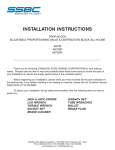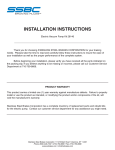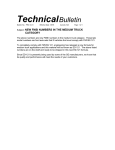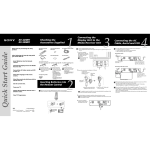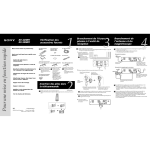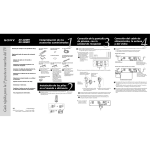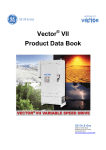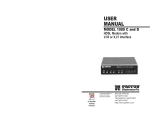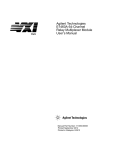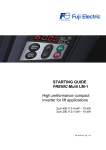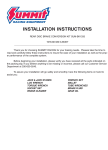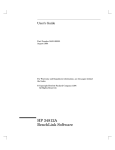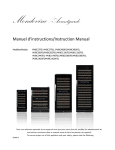Download installation instructions
Transcript
INSTALLATION INSTRUCTIONS REAR DISC BRAKE CONVERSION KIT A126-3 1988-98 CHEVY K1500 4WD 10" DRUMS ____________________________________________________________________ Thank you for choosing STAINLESS STEEL BRAKES CORPORATION for your braking needs. Pleases take the time to read and carefully follow these instructions to insure the ease of your installation as well as the proper performance of the complete system. Before beginning your installation, please verify you have received all the parts indicated on the packing slip. If you believe anything to be missing or incorrect, please call our Customer Service Department at 716-759-8666. To assure your installation will go safely and smoothly, have the following items on hand to assist you: JACK & JACK STANDS LUG WRENCH TORQUE WRENCH SOCKET SET BRAKE CLEANER WRENCH SET TUBE WRENCHES MALLET BRAKE FLUID GEAR OIL Stainless Steel Brakes Corporation • 11470 Main Road • Clarence, NY 14031 Phone: (800) 448-7722 • (716) 759-8666 • Fax: (716) 759-8688 www.ssbrakes.com • [email protected] TIP: BEFORE BEGINNING INSTALLATION, TURN ALL FITTINGS & FASTENERS WITH PENETRATING OIL. 1) Drum Brake Removal a) Raise the truck until the tires and wheels clear the floor and support the truck on jack stands. Remove the tires and wheels from the drum. b) Remove the brake drum from the end of the axle. If the drums will not come off easily, retract the shoes by inserting a narrow screwdriver through the brake adjusting slot and disengage the adjusting lever from the adjusting screw. Then back off the adjusting screw. c) Remove the brake shoes and all the hardware from the backing plate. d) Disconnect parking brake cable from the actuator and pull through the backing plate after compressing the retaining clip. e) Disconnect the rigid brake line from the back of the wheel cylinder. We strongly recommend the use of a tube wrench. BE CAREFUL NOT TO GET BRAKE FLUID ON THE PAINT. IT CAN CAUSE SEVERE DAMAGE. 2) Removal of the Axles & Backing Plates a) Remove differential cover and drain all fluid into a drain pan. b) Working through the opening of the differential, locate and remove the pinion shaft lock bolt. (7mm hex) c) Push pinion shaft out of the differential. d) From the outside, push the axle shafts inward. Through the differential opening, remove the “C” lock from the end of each axle shaft. e) Slide the axle shafts carefully out of the rear end housing. f) Remove the four backing plate retaining nuts and bolts and remove the backing plates. AXLE LENGTH WILL VARY FROM VEHICLE TO VEHICLE. BECAUSE OF THIS, IT MAY BE NECESSARY TO SHIM THE CALIPER MOUNTING STRAPS IN OR OUT. 3) Installation of Caliper Mounting Brackets a) Install the caliper mounting plates over the end of the axle tube and against the mounting flange. The flat edge of the plate will point towards the rear of the truck and the stepped side of the bracket will face in towards the differential. b) Use the bolts that held the drum backing plate on to secure the caliper mounting plates. The bolts should be installed from the outside. c) Install the 7/16-20 x 2” bolts into the top front hole of each mounting bracket. d) Install the 7/16-20 x 1.5” bolts from the outside into each of the 6 remaining holes in the caliper mounting plates. e) Install the caliper mounting bracket over the mounting bolts. The brackets are identical and must point towards the rear of the vehicle. f) On the top front bolt, install 1 of the 3/8” thick spacers provided followed by the parking brake L-bracket. The bolt should pass through the short leg of the bracket. g) Secure the assembly with the 7/16” - 20 elastic stop nuts supplied and torque them to 35 ft / lbs. A126-3 Revision 7 1 4) Axles and Rotors a) Reinstall the axle shafts, C-locks, lock pin and lock bolt in the reverse of removal. BE SURE TO INSTALL A NEW DIFFERENTIAL GASKET AND THE CORRECT GRADE OF GEAR OIL TO THE PROPER LEVEL. b) c) 5) Spray the rotor with brake cleaner to remove the protective packing coating. Slide the rotors onto the axle shaft and temporarily secure rotor to flange with at least one lug nut. Caliper Mounting a) Mount the calipers so that the parking brake actuates as the levers are pulled towards the front of the vehicle. The cables will run over the top of the axle. b) The calipers come prelocked with the brake pads. Slide the calipers over the rotor and secure them to the bracket with the slider bolts supplied. Torque the bolts to 40 ft/lbs. c) Install the hollow block end of the flex hoses to the caliper using the hollow banjo bolts and copper washers provided with the kit. Torque bolts to 15-20 ft / lbs. IF THE CALIPER WILL NOT SLIDE EASILY INTO PLACE OVER THE ROTOR, IT MAY BE NECESSARY TO SHIM THE CALIPER BETWEEN THE BASE BRACKET AND MAIN MOUNTING BRACKET TO ACHIEVE PROPER ALIGNMENT. 6) Brake Lines a) Remove the steel rear axle line at the flex hose and replace them with the ones supplied in the kit. Remember to always use a tube wrench on brake lines. b) Bend the lines along the rear end so they can be connected to the flex hose on the calipers. Secure the lines with the same clips welded to the rear end housing that secured the original lines. MAKE SURE THE FLEX HOSES TAKE A SMOOTH BEND AND DO NOT BECOME KINKED OR TWISTED. 7) Master Cylinder and Distribution Block a) The stock master cylinder must be replaced with the supplied master cylinder to provide the proper pressure and fluid volume for disc brakes. b) Disconnect the original steel lines from the master cylinder using a tube wrench. BE CAREFUL NOT TO GET BRAKE FLUID ON THE PAINT, IT CAN CAUSE SEVERE DAMAGE! c) d) e) f) Remove the two nuts that hold the master cylinder to the power brake booster and pull the master off the brake booster studs. Follow the steel brake line that ran out of the smaller reservoir of the master cylinder. This is the line that feeds the rear brakes. Prior to go into the large ABS unit on the fenderwell, the line will run into a much smaller distribution block. This will be a 5-port steel or brass block. On the end of the block that the line feeds into, there will be a large end nut with a rubber plug in the center. This nut must be removed to in order to modify the block for increased rear brake pressure. A126-3 Revision 7 2 BE CAREFUL NOT TO GET BRAKE FLUID ON THE PAINT, IT CAN CAUSE SEVERE DAMAGE! g) h) i) j) k) Using a box-end wrench, loosen and remove the end nut from the distribution block. Use caution as it is spring-loaded. As you remove the end nut, a spring should also pop out of the block. The spring can be set aside. Next, remove the small aluminum piston from inside the distribution block. It may be necessary to use a pair of needle-nose pliers to pull the piston out. With the piston out, remove the rubber seal from the piston itself. If the seal did not come out on the piston, use a pick or a small screwdriver to remove the seal from inside the block. The inside face of the end nut has a plastic insert with a hole in the center. The end of the piston will push into this plastic insert. Make sure the piton is seated all the way into the end nut. Screw the end nut with the piston back into the distribution block and re-tighten. The spring and the seal should not have been re-installed. NOTE: IN CERTAIN APPLICATIONS, THE STOCK DISTRIBUTION BLOCK CANNOT BE MODIFIED BECAUSE OF FACTORY VARIANCES IN THIS BLOCK. PLEASE SAVE ALL DISTRIBUTION BLOCK PARTS AND NOTE HOW IT WAS ASSEMBLED FROM THE FACTORY. l) m) n) 8) Slide the new master cylinder supplied onto the booster studs and secure using the original nuts. The master cylinder MUST be bench bled as described in the supplied Solutions Guide prior to installation. The supplied brass adapter fitting should be threaded into the rear outlet port of the new master cylinder and tightened with a tube wrench. To connect the original lines, they will need to be slightly rebent. The line with the smaller fitting that originally connected the rear port of the old master cylinder will now connect to the front port of the new master cylinder. The line with the larger fitting that originally connected the front port of the old master cylinder will now connect the rear port of the new master cylinder. Tighten both fittings using a tube wrench. Filling and Bleeding system a) It is advisable to replace the brake fluid if the color is brown or muddy. This is due to water that has been absorbed by the fluid which will eventually corrode the brake lines and master cylinder. This absorbed moisture can also cause a vapor lock situation under extreme braking conditions. Flush system with clean brake fluid and replace with a good grade of disc brake fluid. DOT 3 or DOT 4 fluids are acceptable. b) Bleed the brakes as follows: IF THE MASTER CYLINDER GOES DRY AT ANYTIME DURING THE INSTALLATION, IT MUST BE TAKEN OFF THE VEHICLE AND BENCH BLED. IT CAN THE BE REINSTALLED AND THE REST OF THE SYSTEM CAN BE BLED. A126-3 Revision 7 3 1) 2) With calipers installed, make sure all fittings are tight and master cylinder is topped off. See page 6 for bleeding procedures. MAKE SURE TO KEEP A CLOSE WATCH OVER THE FLUID LEVEL INSIDE THE MASTER CYLINDER DURING THE BLEEDING PROCESS. NEVER LET THE RESERVOIR RUN DRY. ALWAYS KEEP IT AT LEAST 1/3 FULL. 3) 4) 5) After bleeding both wheels and topping of the master cylinder make 20-30 applications of the brake pedal. If a hard pedal is experienced, no further bleeding is required. If pedal is spongy, repeat bleeding process until a hard pedal is achieved. With all bleeding complete, there should be approximately 3/4” to 1” of end play. Power brake cars will experience a “drop off” of the pedal when the engine is started. This is a normal condition that signifies the booster is working. REPLACE ANY ROTTED LINES OR ANY LINES THAT APPEAR WET. LOOK FOR ANY LEAKS BEFORE PROCEEDING. RUBBER HOSES THAT APPEAR WORN SHOULD BE REPLACED! 9) Parking Brake Cable a) Feed parking brake cable over the axle and snap housing end into parking brake L-bracket. b) Compress spring and install clevis onto cable. Crimp clevis slot to prevent cable from slipping out. c) Connect clevis to parking brake arm with clevis pin and cotter pin supplied. If the parking brake lever is not in the proper position, refer to the attached instructions on how to reposition the lever. NOTE: IN CERTAIN APPLICATION, SUCH AS WITH LIFT KITS THE STOCK PARKING BRAKE CABLES MAY NOT BE COMPATIBLE WITH THIS DISC BRAKE KIT. IT IS THE INSTALLER’S RESPONSIBILITY TO SUPPLY PROPER PARKING BRAKE CABLES IN THIS SITUATION. 10) Parking Brake Adjusting a) Advance pistons of calipers so that clearance between pads and rotors is 1/32-1/16”. Piston should be advanced using hydraulic system instead of parking brake levers. About 40 pumps of the pedal are required to extend the pistons to the correct clearance. IF PISTON HAS BEEN EXTENDED TOO FAR, TURN PISTON BACK INTO CALIPER. IF DESIRED, USE SPECIAL TOOL KD-2545 AVAILABLE AT MOST PARTS STORES. A PAIR OF NEEDLE NOSE PLIERS WILL ALSO WORK. b) c) d) e) Set parking brake lever or pedal to released position. Adjust cable so that brakes have a slight drag after two clicks of foot pedal. Test several times so operation is normal to be assured the truck cannot roll. Make sure the parking brake does not drag in the released position. A126-3 Revision 7 4 11) FINAL INSPECTION a) Screw at least two lug nuts on lug studs to hold rotor to axle. b) Spin rotor to check operation. CHECK AGAIN FOR ANY LEAKS! 12) FINAL ASSEMBLY a) Take lug nuts off studs. b) Mount wheel. Torque lug nuts to proper specifications. SPIN WHEEL TO ASSURE THERE ARE NO INTERFERENCES. c) d) Lower truck to ground. Test drive and apply brakes gently but frequently to seat pads. DO NOT USE ANTI-SQUEAK ADHESIVE ON BACK OF PADS. THIS WILL DEGRADE THE PERFORMANCE OF THE CALIPER. DO NOT DRIVE UNTIL BRAKES STOP THE TRUCK WITHOUT A SPONGY FEELING. INITIAL BRAKING TESTS SHOULD BE DONE IN A SAFE, OPEN AREA. IF BRAKES DO NOT OPERATE CORRECTLY, CONTACT ONE OF OUR TECHNICIANS FOR ASSISTANCE. DO NOT DRIVE IN TRAFFIC UNTIL THE BRAKES SAFELY STOP THE CAR A SAFE DISTANCE WITHOUT A SPONGY PEDAL FEEL! BRAKING TESTS SHOULD ALWAYS BE DONE IN A SAFE OPEN AREA! TECH LINE -- If technical help is required, please call 716-759-8666. NOW ENJOY TRUE PERFORMANCE BRAKING!! A126-3 Revision 7 5 1988-99 C, K Series Pickups without 4-wheel ABS 1990-91 C, K Series Pickups with 4-wheel ABS Bleeding Sequence: Master cylinder, if serviced 1) Right Rear 2) Left Rear 3) Right Front 4) Left Front Bleeding Sequence: Master cylinder, if serviced 1) Isolation/dump valve (under master cylinder) 2) Right Rear 3) Left Rear 4) Right Front 5) Left Front Special Procedures: When using pressure equipment, use a special tool to depress the metering plunger on the combination valve. Special Procedures: 1993, 1995-98 C, K Series Pickups with 4-wheel ABS 1992, 1994 C, K Series Pickups with 4-wheel ABS Bleeding Sequence: Master cylinder, if serviced 1) Right Rear 2) Left Rear 3) Right Front 4) Left Front 5) Brake pressure modulator valve (BPMV) as equipped Bleeding Sequence: Master cylinder, if serviced 1) Brake Pressure Modulator Valve (BPMV) 2) Right Rear 3) Left Rear 4) Right Front 5) Left Front Special Procedures: Special Procedures: When using pressure equipment, use a special tool to depress the metering plunger on the combination valve. Gravity and vacuum bleeding are not recommended for this system. With ABS, Brake Pressure Modulator Valve (BPMV) or Hydraulic Control Unit (HCU) have been replaced or are suspected of having air trapped inside, bleed as follows: 1) Bleed the wheel brakes in above sequence. 2) Firmly apply the brake pedal & perform three (1993) or four (1996-98) function tests with the Tech 1 scan tool. 3) Rebleed the wheel brakes in the above sequence. Inspect brake pedal feel, repeat procedure as necessary. When using pressure equipment, use a special tool to depress the metering plunger on the combination valve. The BPMV should be bled if it has been replaced or it is suspected of having air trapped inside. Bleed this unit before any of the wheel brakes: 1) Open the internal bleed valves on each side of the 1/2 turn. 2) Install special tool J39177 (combination valve depressor) on the left side high pressure accumulator bleed stem on the unit. 3) Install the J39177 tool on the right side high pressure accumulator bleed stem on the unit. 4) Install J39177 tool on the combination valve. 5) Bleed the wheel brakes in above sequence. 6) Remove the special tools and close the bleed valves. 7) Connect a Tech 1 and turn on ignition and run through six functional tests. 8) Bleed the wheel brakes again. Inspect brake pedal feel and brake performance. A126-3 Revision 7 When using pressure equipment, use a special tool to depress the metering plunger on the combination valve. 6 Instructions for Repositioning Parking Brake Lever. Photo 1: For some applications, it may be necessary to change the position of the parking brake lever to allow connection of the brake cables. Photo 2: Using a 3/4" open end wrench, loosen and remove the retaining nut. A126-3 Revision 7 7 Photo 3: With the retaining nut removed, the parking brake return spring can be removed. Notice how the spring fits with the loop hooked onto the parking lever and the straight end pushed into the hole on the back of the caliper. Photo 4: The parking brake lever can now be removed from the stud. Rocking the lever up and down will help free the lever from the stud. A126-3 Revision 7 8 Photo 5: Install the lever in the new position, making sure the notches in the lever align with the hex shoulder of the stud. This insures the lever will turn the stud and not simply spin without engaging the parking brake. Photo 6: Reinstall the spring and retaining nut. Be sure to install the straight end of the spring into a hole in the back of the caliper; this will create spring tension as soon as the lever is moved. A126-3 Revision 7 9 Photo 7: Tighten the retaining nut with a 3/4" open end wrench while holding the parking brake lever. Photo 8: The caliper is now ready for installation. A126-3 Revision 7 10 NOTE: When you remove this nut, brake fluid will leak out. Make sure you keep fluid in the master cylinder at all times. Distribution Block Remove this nut on back side of block. Pull out the piston and spring. Put these parts aside. Remove rubber seal. Push piston in endnut. Replace endnut and piston into distribution block. Distribution Block Addendum A126-2, A126-3 & A126-51 Revision 1 1 NOTE: When you remove this nut, brake fluid will leak out. Make sure you keep fluid in the master cylinder at all times. Pull out the piston and spring. Remove this nut from valve body. Put these parts aside. Remove seal from piston. Push piston into endnut. Distribution Block Addendum A126-2, A126-3 & A126-51 Revision 1 2 Replace piston and endnut. If your distribution block has no nut on this end, you have no residual pressure. No modifications will be necessary for your system. Distribution Block Addendum A126-2, A126-3 & A126-51 Revision 1 3 Solutions Guide to commonly asked questions. Why is my brake pedal soft? How do you bench bleed a Master Cylinder? 1) In most cases, Air is trapped in the lines or calipers. Try re-bleeding the system. Do not force new fluid into new brake lines. It may foam and be very difficult to bleed. Make sure that the bleeder screws on the calipers are facing upward! Secure one of the ears in a vise so that you can take a large screwdriver and push the piston in. Fill the reservoir with clean fluid. Take a dummy line or our M/C bleeding kit and hook it up to the two ports. Front line to front and rear line to rear reservoirs. Slowly stroke the master and let it return slowly. You should see many air bubbles in the fluid. Repeat this step until you do not see any more air bubbles. SSBC recommends ten (10) slow pumping strokes after you see no more air bubbles. This will insure a good hard pedal. (See SSBC part #0460 Instruction Sheet) 2) If all the air is out of the system, the pushrod from the booster may need adjustment, under the dash, to make it longer. Do not extend it too long or it will not allow the fluid to return, causing brakes to drag. Your pushrod may not be adjustable. If the pushrod can be made longer, try ¼ turn adjustments at a time. SSBC stocks adjustable pushrods for many vehicles. In addition, the pushrod between the Booster and the Master Cylinder may need adjustment. Not all Booster to Master pushrods are adjustable. What is the best pad for my vehicle? Your choice of pads should be determined by how and where you drive the vehicle. If you drive in heavy stop and go traffic you would need a different pad than someone who is road racing. Contact SSBC for the correct application. 3) You may have a bad Master Cylinder. Before you determine this, you should make sure that all the air is out of the system. When installing a new Master Cylinder, always bench bleed first. If you did not, take off the Master Cylinder and bench bleed it. (See Bench Bleeding Instructions below) How often should brake fluid be changed? (street application only, not racing) Why does the car pull to one side? The side that the car is pulling to is the caliper that is working. Re-bleed the opposite side and try carefully stopping again. When brake fluid turns brown, it is time to change the fluid. The brown color indicates that the fluid has absorbed water and dirt. D.O.T. #3 & #4 fluids absorb water. Silicone brake fluid is not for track racing. Why does it feel like there is no Power Assist? How can I tell which reservoir is the front or rear of the Master Cylinder? The Booster may not be getting enough vacuum to operate. On some high lift cams, the engine does not develop enough vacuum. The Booster needs at least 16” of vacuum to operate correctly at idle. If you do not have at least 16 inches of vacuum at idle, you may have to add a vacuum pump to your system. Check for vacuum leaks. There may be leaks in the intake manifold or hoses that would cause low vacuum. The Booster may be bad. Do a vacuum test. If the Booster can retain a vacuum for three (3) minutes after the vehicle is shut off, it is not a bad Booster (refer to steps 1 & 2). All Master Cylinders must be bench bled in a vise before being installed on the vehicle. Solutions Guide Revision 5 The front reservoir is usually larger than the rear. In some cases, they are the same size. As a rule, for GM cars & trucks, the rear reservoir is for the rear brakes. On Ford cars & trucks, the front reservoir is for the rear brakes. On front wheel drive vehicles, the brakes are split diagonally. Each bowl of the master cylinder services one front wheel and one rear wheel. This will be important if you are installing a distribution block, proportioning valve, or residual valve. Hint: The larger bowl will feed the disc brakes. 1 716-759-8666 • [email protected] Where is the best place to install a proportioning valve? How much brake pressure does it take to stop my vehicle? The best place to install a proportioning valve is after the distribution block. Do Not install it between the Distribution Bock and the Master Cylinder. You will not be able to get a hard pedal. Anywhere after the Distribution Block and before the rear flex hose is acceptable for installation. Most vehicles, power or non power brake, develop 1,200 P.S.I. When you panic stop or jump on the brakes hard, a surge of 1,400 P.S.I. can be achieved. If a factory proportioning valve installed on the vehicle, the rear brakes are only developing 600 – 700 P.S.I. Drum brakes require lower pressure because they grab more quickly. When rear disc brakes are installed, the rear brake pressure may be increased to 800 – 1,000 P.S.I. or more. A good way to check the pressures and to see if the system is working correctly, use a pressure gauge screwed into the bleeder port (SSBC part # A1704). A vehicle with less than 600 P.S.I will not stop! Why should the flex hoses be replaced? They look O.K. from the outside. Flex hoses should be replaced every time the calipers are serviced. They flex up and down, just like a shock absorber. They are also under high pressure internally. Flex hoses have a rubber liner that will collapse over time. If it does collapse, it will act as a check valve and not allow fluid to return to the Master Cylinder. How tight should the wheel bearings be? The front bearings should always be torqued. Not just hand tightened. Bearings usually require 12-15 Ft./Lbs. of torque. Then you will probably need to back off a little to align the cotter pin hole. Do Not over tighten; the bearing life will be shortened. This procedure only applies to rear wheel drive vehicles with separate bearings and races. On vehicles with one piece sealed bearing assemblies or hub assemblies, refer to a service manual. Will my pedal get harder by replacing the flex hoses? No. When the flex hoses are replaced, re-bleed the brake system. Normally what happens is that bleeding causes a harder brake pedal. A better bleeding job and taking your time will result in the same situation. What type of differential fluid should I use in my rear axle? Are the rubber flex hoses expanding causing a soft pedal? If you have positraction, use a Hypoid or Limited Slip additive that is designed for your particular rear end. If you do not have positraction, any type of 80 –90 weight gear lube is acceptable. Fluid should be changed often if you are trailering or any type of extreme usage. This fluid does brake down with time and usage. Not likely. A soft pedal is usually a sign of air in the system due to poor bleeding. Flex hoses have nylon webbing that is molded into the internal rubber. It is very strong and will hold up to 3,000 P.S.I. Installing braided stainless steel hoses is not necessary; it only improves appearance. Solutions Guide Revision 5 2 716-759-8666 • [email protected] Replacement Pads for SSBC Performance Brake Kits SSBC Kit # SSBC Pad # FMSI # SSBC Kit # SSBC Pad # FMSI # SSBC Kit # SSBC Pad # FMSI # SSBC Kit # SSBC Pad # FMSI # A109 A109-1 A109AF A109AR A109S A110 A110-10 A110-11 A110-12 A110-13 A110-14 A110-15 A110-16 A110-17 A110-18 A110-19 A110-2 A110-3 A110-4 A110-5 A110-6 A110-7 A110-8 A110-9 A111 A111-10 A111-11 A111-12 A111-13 A111-14 A111-15 A111-16 A111-17 A111-18 A111-19 A111-2 A111-20 A111-21 A111-22 A111-23 A111-24 A111-25 A111-26 A111-27 A111-28 A111-29 A111-3 A111-30 A111-31 A111-32 A111-33 A111-4 A111-5 A111-6 A111-7 A111-8 A111-9 A112 A112-1 A112-11 A112-12 A112-13 A112-14 A112-15 A112-16 A112-17 1012 10108 10128 10128 1012 1049 10129 10113 10113 1015 10135 1095 10128 10128 1047 10113 1047 10128 10128 1015 1015 10110 10110 10129 1049 1015 1015 10110 10110 10110 10110 10129 10129 10129 10129 1047 10113 10113 10113 10113 1015 10135 1095 10128 1015 10129 10135 1095 10128 10128 10128 10128 10128 10128 10128 A1015-3 1015 1047 1047 1095 1095 10113 1047 1047 1095 10133-1 D-8 D-531 D-531 D-531 D-8 D-204 D-43 D-154 D-154 D-52 D-137 D-731 D-531 D-531 D-347 D-154 D-347 D-531 D-531 D-52 D-52 D-11 D-11 D-43 D-204 D-52 D-52 D-11 D-11 D-11 D-11 D-43 D-43 D-43 D-43 D-347 D-154 D-154 D-154 D-154 D-52 D-137 D-731 D-531 D-52 D-43 D-137 D-731 D-531 D-531 D-531 D-531 D-531 D-531 D-531 * D-52 D-347 D-347 D-731 D-731 D-154 D-347 D-347 D-731 D-784 A112-2 A112-3 A112-4 A112-5 A112-6 A112-7 A112-8 A112-9 A112-93 A113 A113-1 A113-10 A113-11 A113-12 A113-4 A113-5 A113-6 A113-7 A113-8 A113-9 A114 A115 A116 A117 A117-1 A117-10 A117-11 A117-12 A117-13 A117-14 A117-15 A117-2 A117-3 A117-4 A117-5 A117-6 A117-7 A117-8 A117-9 A118 A120 A120-10 A120-11 A120-12 A120-2 A120-2P A120-2PO A120-2PPO A120-3 A120-4 A120-5 A120-6 A120-7 A120-7A A120-7M A120-8 A120-9 A120D A120P A121 A121-2P A121-2PA A121-2PAPO A121-2PM A121-2PMPO A121P 1047 1071 1047 1061-1 10128 1071 10128 1015 1047 1071 1071 1071 1015 1095 10128 1015 10128 10128 1070 10128 1047 1047 1049 1047 1047 10113 1095 1095 10113 10113 10113 1047 1071 1071 10128 10128 10128 1047 1095 1049 A1033 10128 10128 10128 10110 10110 10129 10129 10128 10144 10144 10128 10128 10128 10128 10128 10128 A1033 A1033 A1033 10110 10110 10110 10110 A10129 A1033 D-347 D-412 D-347 D199 D-531 D-412 D-531 D-52 D-347 D-412 D-412 D-412 D-52 D-731 D-531 D-52 D-531 D-531 D-413 D-531 D-347 D-347 D-204 D-347 D-347 D-154 D-731 D-731 D-154 D-154 D-154 D-347 D-412 D-412 D-531 D-531 D-531 D-347 D-731 D-204 * D-531 D-531 D-531 D-11 D-11 D-43 D-43 D-531 D-289 D-289 D-531 D-531 D-531 D-531 D-531 D-531 * * * D-11 D-11 D-11 D-11 * * A121P-A A121P-M A123 A123-1 A123-13 A123-14 A123-15 A123-16 A123-17 A123-18 A123-1A A123-1C A123-2 A123-3 A123-3A A123-4 A123-4A A123-5 A123-58 A123-58A A123-59 A123-59A A123-5A A123-6 A123-67 A123-68 A123-69 A123-6A A123-7 A123-8 A123-9 A123-A A124 A125 A125-1 A125-10 A125-11 A125-12 A125-13 A125-14 A125-15 A125-16 A125-17 A125-18 A125-19 A125-1F A125-2 A125-20 A125-21 A125-22 A125-23 A125-24 A125-25 A125-26 A125-27 A125-28 A125-29 A125-3 A125-30 A125-31 A125-32 A125-33 A125-34 A125-35 A125-36 A125-4 A1033 A1033 1050 1050 1095 1095 10116 10116 1095 1095 1015 1050 1071 1050 1015 1050 1015 1050 1050 1015 1050 1015 1015 1071 1071 1071 1071 1071 10128 10128 10128 1015 1047 1047 1047 10128 10128 10128 10128 1015 1015 1015 1015 10110 10110 1047 1047 10110 10128 10129 10129 10129 10129 10113 10113 10113 10113 1047 10113 1015 1015 10135 1095 10128 10128 1047 * * D-52 D-52 D-731 D-731 D-749 D-749 D-731 D-731 D-52 D-52 D-412 D-52 D-52 D-52 D-52 D-52 D-52 D-52 D-52 D-52 D-52 D-412 D-412 D-412 D-412 D-412 D-531 D-531 D-531 D-52 D-347 D-347 D-347 D-531 D-531 D-531 D-531 D-52 D-52 D-52 D-52 D-11 D-11 D-347 D-347 D-11 D-531 D-43 D-43 D-43 D-43 D-154 D-154 D-154 D-154 D-347 D-154 D-52 D-52 D-137 D-731 D-531 D-531 D-347 A125-5 A125-6 A125-7 A125-8 A125-9 A125-F A125P A126 A126-1 A126-10 A126-11 A126-12 A126-13 A126-14 A126-15 A126-16 A126-17 A126-18 A126-19 A126-2 A126-20 A126-21 A126-22 A126-23 A126-24 A126-25 A126-26 A126-27 A126-28 A126-29 A126-3 A126-30 A126-31 A126-32 A126-33 A126-34 A126-35 A126-37 A126-38 A126-39 A126-4 A126-40 A126-41 A126-46 A126-5 A126-51 A126-6 A126-61 A126-7 A126-71 A126-71A A126-7A A126-8 A126-9 A127 A127-1 A127-2 A127-3 A127-4 A127-5 A127-6 A127-7 A127-8 A127-9 A128 A128-1 1047 1047 1047 10128 10128 1047 1047 1070P 1047 1015 1015 1015 1094A 1094A 1094A 1094A 1094A 1015 1094A 1047 1015 10129 10128 10128 10128 10128 10128 10128 10128 10128 A1094B 10128 10128 1015 10128 10128 10128 1095 1095 1095 A1094B 10126 10126 10126 1047 1047 1050 1050 1094 1094 A1094 A1094 1094 1049 1047 10128 1070 1071 10128 10128 1015 1047 1015 1047 1047 1047 D-347 D-347 D-347 D-531 D-531 D-347 D-347 D-413 D-347 D-52 D-52 D-52 D-370 D-370 D-370 D-370 D-370 D-52 D-370 D-347 D-52 D-43 D-531 D-531 D-531 D-531 D-531 D-531 D-531 D-531 * D-531 D-531 D-52 D-531 D-531 D-531 D-731 D-731 D-731 * D-834 D-834 D-834 D-347 D-347 D-52 D-52 D-369 D-369 * * D-369 D-204 D-347 D-531 D-413 D-412 D-531 D-531 D-52 D-347 D-52 D-347 D-347 D-347 *RE-ORDER PADS DIRECTLY FROM SSBC Solutions Guide Revision 5 3 716-759-8666 • [email protected] ...Replacement Pads Continued SSBC Kit # SSBC Pad # FMSI # SSBC Kit # SSBC Pad # FMSI # SSBC Kit # SSBC Pad # FMSI # SSBC Kit # SSBC Pad # FMSI # A128-2 A128-3 A128-4 A128-5 A128-6 A128-7 A129 A129-1 A129-10 A129-12 A129-13 A129-1A A129-2 A129-20 A129-22 A129-23 A129-24 A129-2A A129-3 A129-3A A129-4 A129-4A A129-5 A129-6 A129-8 A129-A A130 A130-1 A130-2 A132 A132-1 A132-A A132-M A133 A133-1 A133-2 A133-2P A133-3 A133-3P A133-3PO A134 A134-1 A134-1P A134-1PPO A135 A135-1 A135-1A A135-2 A135-3 A136 A136-1 A137 A137-1 A137-1A A137-2 A137-3 A137-3A A138 A138-1 A138-1A A138-2 A138-3 A138-4 A138-A A140 A140-1 1047 1049 1047 1049 1047 1047 1050 1050 10128 1050 1050 1015 1050 10128 1095 10128 1095 1015 1050 1015 1050 1015 1071 10128 10128 1015 1047 1047 1047 1046 1046 1046 1046 1046 1046 A1033 A1033 10110 10110 10129 1046 1046 10110 10110 1050 1094A A1094 1094 10110 1047 1047 1012 1050 1015 10128 1050 1015 1084-2 1084-2 10113 1050 1050 1050 10113 1084-2 10128 D-347 D-204 D-347 D-204 D-347 D-347 D-52 D-52 D-531 D-52 D-52 D-52 D-52 D-531 D-731 D-531 D-731 D-52 D-52 D-52 D-52 D-52 D-412 D-531 D-531 D-52 D-347 D-347 D-347 D-34 D-34 D-34 D-34 D-34 D-34 * * D-11 D-11 D-43 D-34 D-34 D-11 D-11 D-52 D-370 * D-369 D-11 D-347 D-347 D-8 D-52 D-52 D-531 D-52 D-52 D-154 D-154 D-154 D-52 D-52 D-52 D-154 D-154 D-531 A141 A141-1 A142 A142-1 A143 A143-1 A143-5 A143-58 A143-59 A144 A144-1 A145 A145-1 A146 A146-1 A148 A148-1 A148-14 A148-14A A148-15 A148-15A A148-16 A148-16A A148-17 A148-17A A148-18 A148-18A A148-1A A148-2 A148-22 A148-23 A148-23FS A148-23FSE A148-23RS A148-23RSE A148-24FSE A148-24RS A148-24RSE A148-25FSE A148-25RSE A148-26 A148-26FS A148-26RS A148-27 A148-27FS A148-27RS A148-28 A148-29 A148-3 A148-30 A148-30E A148-31 A148-31A A148-32 A148-32A A148-33 A148-34 A148-4 A148-4E A148-5 A148-6F A148-6FE A148-6G A148-6GE A148-7F A148-7FE 1084-2 1071 1050 1071 1084-2 1071 1084 1084 1084 1084-2 1071 1084-2 1071 1071 1084-2 1084-2 1084-2 1050 1015 1050 1015 1050 1015 1050 1015 1050 1015 10113 A1033 1050 10110 10110 10129 10110 10129 10129 10110 10129 10129 10129 10128 10128 10128 10128 10128 10128 10128 10128 A1033 10110 10129 1084-2 10113 1084-2 10113 1095 1095 10110 10129 10110 A1033 10129 A1033 10129 10110 10129 D-154 D-412 D-52 D-412 D-154 D-412 D-154 D-154 D-154 D-154 D-412 D-154 D-412 D-412 D-154 D-154 D-154 D-52 D-52 D-52 D-52 D-52 D-52 D-52 D-52 D-52 D-52 D-154 * D-52 D-11 D-11 D-43 D-11 D-43 D-43 D-11 D-43 D-43 D-43 D-531 D-531 D-531 D-531 D-531 D-531 D-531 D-531 * D-11 D-43 D-154 D-154 D-154 D-154 D-731 D-731 D-11 D-43 D-11 * D-43 * D-43 D-11 D-43 A148-7G A148-7GE A148-A A150 A150-1 A150-2 A151 A151-1 A151-2 A152 A152-1 A153 A153-1 A153-2 A153-3 A154 A154-1 A154-2 A154-3 A154-4 A154-5 A154-6 A155 A155-1 A155-2 A156 A156-1 A156-2 A156-3 A156-4 A157 A157-1 A157-2 A158 A158-1 A158-2 A158-3 A158-4 A159 A159-1 A160 A160-1 A160-2 A160-3 A160-4 A161 A161-1 A161-2 A162 A162-1 A162-2 A162-3 A163 A163-1 A163-2 A163-3 A163-4 A163-5 A163-6 A163-7 A163-8 A163-9 A164 A164-1 A164-10 A164-11 10110 10129 10113 1047 1047 1047 1071 10113 1095 A1033 10110 A1033 A1033 10110 10110 A1033 A1033 10110 10110 A1033 A1033 1095 1047 1047 1047 A1033 A1033 10110 10110 1095 1047 10128 10128 1047 1047 1094A 1094A 10128 10100 1094A 10128 1047 1015 1015 1047 1015 1047 1015 1095 10113 1095 10113 1015 1047 1015 1015 1047 1015 10113 10113 10113 10113 10128 10128 10128 10128 D-11 D-43 D-154 D-347 D-347 D-347 D-412 D-154 D-731 * D-11 * * D-11 D-11 * * D-11 D-11 * * D-731 D-347 D-347 D-347 * * D-11 D-11 D-731 D-347 D-531 D-531 D-347 D-347 D-370 D-370 D-531 D-268 D-370 D-531 D-347 D-52 D-52 D-347 D-52 D-347 D-52 D-731 D-154 D-731 D-154 D-52 D-347 D-52 D-52 D-347 D-52 D-154 D-154 D-154 D-154 D-531 D-531 D-531 D-531 A164-12 A164-13 A164-14 A164-15 A164-16 A164-17 A164-2 A164-3 A164-4 A164-5 A164-6 A164-7 A164-8 A164-9 A165 A165-1 A165-2 A165-3 A165-4 A166-1 A166-10 A166-13 A166-14 A166-15 A166-16 A166-17 A166-18 A166-19 A166-1A A166-2 A166-20 A166-21 A166-22 A166-23 A166-24 A166-25 A166-26 A166-27 A166-28 A166-29 A166-3 A166-30 A166-3A A166-4 A166-5 A166-6 A166-7 A166-8 A166-9 A167 A167-1 A167-2 A167-3 A167-4 A167-5 A168 A168-1 A168-10 A168-11 A168-2 A168-3 A168-4 A168-5 A168-6 A168-7 A168-8 10128 10129 10128 10126 10128 10126 10128 10128 10128 10128 10128 10128 10128 10128 10128 10128 1095 1095 10133-1 1015 1015 1015 1015 10128 1015 1015 10128 1015 1015 10128 1015 10108 1047 A1015-3 1015 1047 1047 1047 1047 1047 1015 1047 1015 10128 1015 1015 1015 1015 10128 1015 1015 10128 1015 1015 10128 1015 1015 1015 1015 10128 1015 1015 10128 1015 1015 10128 D-531 D-43 D-531 D-834 D-531 D-834 D-531 D-531 D-531 D-531 D-531 D-531 D-531 D-531 D-531 D-531 D-731 D-731 D-784 D-52 D-52 D-52 D-52 D-531 D-52 D-52 D-531 D-52 D-52 D-531 D-52 D-531 D-347 * D-52 D-347 D-347 D-347 D-347 D-347 D-52 D-347 D-52 D-531 D-52 D-52 D-52 D-52 D-531 D-52 D-52 D-531 D-52 D-52 D-531 D-52 D-52 D-52 D-52 D-531 D-52 D-52 D-531 D-52 D-52 D-531 *RE-ORDER PADS DIRECTLY FROM SSBC Solutions Guide Revision 5 4 716-759-8666 • [email protected] ...Replacement Pads Continued SSBC Kit # SSBC Pad # FMSI # A170 A170-1 A171 A171-1 A171-2 A171-3 A172 A172-1 A172-2 A172-3 A172-4 A172-5 A172-6 A173 A173-1 A173-3 A174 A174-1 A180-M A180-S A181 A182 A185-M A185-S A186-1 A187 A187-1 A187-2 A187-3 A187-4 A188 A188-1 A189 A189-1 A190 A191 A192 A193 A193-1 A194 1015 10128 1015 1015 10128 1047 1015 1015 1047 1015 1015 1015 1015 10128 10128 A10135 1015 1015 1015 1015 10113 10113 1015 1015 A1094 1095 1095 10126 10126 10133-1 10110 10110 10110 1095 A10129 10129 10135 1095 10133-1 1097 D-52 D-531 D-52 D-52 D-531 D-347 D-52 D-52 D-347 D-52 D-52 D-52 D-52 D-531 D-531 * D-52 D-52 D-52 D-52 D-154 D-154 D-52 D-52 * D-731 D-731 D-834 D-834 D-784 D-11 D-11 D-11 D-731 * D-43 D-137 D-731 D-784 D-614 Short Stop...™ Slotted Rotor Upgrade Kits SSBC Kit # SSBC Pad # FMSI # A2350000 A2350001 A2350002 A2350003 A2350004 A2350004R A2350005 A2350006 A2350007 A2350008 A2350008R A2350009 A2350009R A2350010 A2350012 A2350013 10112 1015 1015 10113 1099(F) 1070(R) 1070 10101(F) 10102(R) 1081(F) 1070(R) 1081(F) 1070(R) 1095(F) 1096(R) 1096 1097(F) 1098(R) 1097(F) 1098(R) 1015 1015 1081 D-8 D-52 D-52 D-154 D-623(F) D-413(R) D-413 D-294(F) D-295(R) D-412 (F) D-413(R) D-412 (F) D-413(R) D-731(F) D-732(R) D-732 D-614(F) D-628(R) D-614(F) D-628(R) D-52 D-52 D-412 SSBC Kit # SSBC Pad # A2350014 A2350014R A2351000 A2351001 A2351002 A2351003 A2351004 A2351005 A2351006 A2351007 A2351008 A2351009 A2351010 A2351011 A2351012 A2351013 A2351014 A2351015 A2351016 A2351017 A2351018 A2351019 A2351020 A2351021 A2351022 A2351023 A2351024 A2351025 A2351026 A2351027 A2351028 A2360000 A2360001 A2360002 A2360003 A2360004 A2360005 A2360006 A2360007 A2360008 A2360009 A2360010 A2360011 A2361001 A2361002 A2361003 A2370000 A2370001 A2370002 A2370003 A2370004 A2370005 A2370006 A2370007 A2370008 A2370009 A2370010 A2370011 A2370012 A2370013 A2370014 A2370015 A2370016 A2370017 A2380001 A2380002 10116 D-749 10117 D-750 1015 D-52 1015 D-52 1015 D-52 10100 D-368 1094 D-369 1094 D-369 1094 D-369 1015 D-52 10100 D-368 1094 D-369 1094 D-369 1015 D-52 1094 D-369 1015 D-52 1094 D-369 1015 D-52 1094 D-369 10113 D-154 10113 D-154 10118(F) 10119(R) D-785(F) D-792(R) 10126 D-834 10119 D-792 10118 D-785 10113 D-154 10133-1 D-784 10118(F) 10143(R) D-785(F) D-974A(R) 10143 D-974A 10133-1(F) 10134(R) D-784(F) D-785(R) 10133-1 D-784 A1033 * 1046 D-34 1046 D-34 1066 D-237 1061(F) 1049(R) D-199(F) D-204(R) 1061 D-199 10103(F) 10104(R) D-600(F) D-627(R) 1081(F) 10145(R) D-412(F) D-627A(R) 1061-1(F) 1047(R) D-199(F) D-347(R) 10127 D-711 10127 D-711 10137(F) 10104(R) D-491(F) D-627(R) 10146(F) 10147(R) D-749(F) D-1012(R) 10146(F) 10147(R) D-749(F) D-1012(R) 10147 D-1012 1092 D-203 1092 D-203 1093 D-477 1015 D-52 1093 D-477 10111 D-529 1094 D-369 1094 D-369 10111 D-529 10111 D-529 10111 D-529 10114 D-746 10120 D-820 10125 D-702 10125 D-702 1093(F) 10139(R) D-477(F) D-666(R) 10140(F) 10141(R) D-790(F) D-791(R) 10142(F) 10141(R) D-945(F) D-791(R) 10121(F) 10122(R) D-591(F) D-512(R) 10123(F) 10124(R) D-592(F) D-592(R) FMSI # *RE-ORDER PADS DIRECTLY FROM SSBC Solutions Guide Revision 5 5 716-759-8666 • [email protected] REPLACEMENT PARTS ORDER FORM Stainless Steel Brakes Corporation 11470 Main Road • Clarence, NY 14031 Ph: 716-759-8666 Fx: 716-759-8688 ssbrakes.com • [email protected] DATE: __________________________ CUSTOMER # ORDERED BY: SHIP TO: NAME: _______________________________ NAME: _______________________________ COMPANY: ____________________________ COMPANY: ____________________________ STREET: ______________________________ STREET: ______________________________ CITY: ___________ ST: ____ ZIP: _________ CITY: ___________ ST: ____ ZIP: _________ DAY PHONE: ___________________________ DAY PHONE: ___________________________ FAX: _________________________________ FAX: _________________________________ E-MAIL: ______________________________ E-MAIL: ______________________________ VEHICLE INFORMATION: TYPE OF DRIVING: TYPE OF (from receipt): ____________ AUTOMOBILE: _________________________ __ STREET YEAR ______ ENGINE: __ 4 CYL. __ 6 CYL. __ 8 CYL. __ RACING __ STREET & SLALOM ORDER INFORMATION: QUANTITY PART # DESCRIPTION UNIT PRICE ORDER __ VISA AMOUNT Total Merchandise METHOD OF PAYMENT: __ CHECK/MONEY __ STREET MODIFIED __ MASTERCARD __ DISCOVER __ AMEX NY Residents Sales Tax Ins. (add $0.35 per $100.00) CREDIT CARD #: _____________________________ EXP: _____________ SIGNATURE: ___________________________________________________ UPS Shipping (please call) TOTAL Price subject to change without notice. Not responsible for typographical errors. NOTE: Name, address & telephone number must be printed on checks. Driver’s License number required for personal checks. FREE FREIGHT IF ORDERED WITHIN 30 DAYS OF INITIAL ORDER MAIL OR FAX YOUR ORDER! Solutions Guide Revision 5 6 716-759-8666 • [email protected] How and why do I bench bleed a master cylinder? When installing or replacing a master cylinder, it is critical that all air is removed from the master cylinder. This can easily be done by bench bleeding the master cylinder prior to installation. Using the SSBC master cylinder bleeder kit (#0460): 1) Place your master cylinder in a vise by the ears (not body). Make sure it is level. 2) Attach a piece of clear plastic hose to the short end of one of the plastic nozzles. Do the same to the other hose and nozzle. 3) Clip the plastic bridge to the wall and push the ends of the hose through the holes so they are SUBMERGED in the reservoir on either side of the wall. 4) Press the tapered end of the nozzle FIRMLY into the cylinder port hole with a twisting motion. Repeat this procedure on the other port hole. 5) Fill the reservoir with CLEAN brake fluid recommended by the manufacturer. 6) Using full strokes, push the piston in, then release. Do this until ALL the air bubbles have disappeared from the clear plastic hose. (CAUTION-MASTER CYLINDER WILL NOT BLEED PROPERLY UNLESS HOSES ARE SUBMERGED IN BRAKE FLUID UNTIL THE BLEEDING PROCESS IS COMPLETED.) Now mount master cylinder and avoid brake fluid leaking out of front and rear ports during installation. Bleeding steps for Dual Port Master Cylinder If you have a master cylinder with dual port holes (4 port holes - 2 on each side), it is necessary to bleed both port sides of the master cylinder. If both sides of the master cylinder are not bled, there will be air trapped in the master cylinder and your brakes will not function properly. To bleed dual port master cylinders: 1) Follow steps 1 - 6 above on the side you will be hooking the brake lines to. Plug the other side. 2) Once the air bubbles are no longer visible in the plastic hose, open the bleeder screws in the supplied plugs and allow the mater cylinder to gravity bleed. DO NOT push the master cylinder piston in while the plugs are gravity bleeding. 3) When clear, steady streams of fluid are coming out of both bleeders, close and tighten the bleeders. Give the master cylinder piston several strokes, making sure there are still no bubbles present in the clear plastic tubes. 4) Remove the tubes and plastic fittings and mount the master cylinder on the vehicle being careful not to spill brake fluid on any painted surfaces. Solutions Guide Revision 5 7 716-759-8666 • [email protected] TORQUE SPECIFICATIONS BEFORE DRIVING YOUR VEHICLE, YOU SHOULD CHECK THE TORQUE ON ALL NUTS AND BOLTS IN THE KIT, INCLUDING ANY SLIDER BOLTS ON THE CALIPERS. RE-TORQUE CALIPER BOLTS AFTER 500 MILES. ALL SPECIFICATIONS ARE IN FT-LBS. BOLT GRADES U.S. Bolt Grade Bolt Dia. 1/4” 1/4” 5/16” 5/16” 3/8” 3/8” 7/16” 7/16” 1/2” 1/2” 9/16” 9/16” 5/8” 5/8” 3/4” 3/4” 7/8” 7/8” 1” 1” SAE 7 SAE 8 5.8 8.8 9.8 10.9 Low Carbon (soft) Medium Carbon Heat Treat Medium Carbon Alloy 2 5 5 7 7 8 8 Thread Dry per inch Oiled Dry Oiled Dry Oiled Dry 20 28 18 24 16 24 14 20 13 20 12 18 11 18 10 16 9 14 8 12 4 6 9 12 16 22 24 34 38 52 52 71 98 115 157 180 210 230 320 350 3 4 7 9 12 16 17 26 31 42 42 57 78 93 121 133 160 177 240 265 8 10 17 19 30 35 50 55 75 90 110 120 150 180 260 300 430 470 640 710 6 7 13 14 23 25 35 40 55 65 80 90 110 130 200 220 320 360 480 530 10 12 21 24 40 45 60 70 95 100 135 150 140 210 320 360 520 580 800 860 8 9 16 18 30 35 45 50 70 80 100 110 140 160 240 280 400 440 600 666 12 14 25 29 45 50 70 80 110 120 150 170 220 240 380 420 600 660 900 990 Bolt Dia. 5.8 Oiled 8.8 Oiled 9.8 Oiled 10.9 Oiled 5mm 6mm 8mm 10mm 12mm 3.5 6 15 29 51 5 9 22 44 76 6 10.5 25 51 89 8 12 32 62 111 METRIC 2 SAE 5 Metric Steel Type SAE SAE 2 Solutions Guide Revision 5 Medium Carbon Alloy Oiled Socket Head Cap Screw Dry Socket Head Cap Screw Oiled 9 10 18 20 35 40 55 60 80 90 110 130 170 180 280 320 460 500 680 740 14 16 29 33 49 54 76 85 113 126 163 181 230 255 400 440 640 700 980 1060 11 13 23 26 39 44 61 68 90 100 130 144 184 204 320 350 510 560 780 845 Per SAE J1701 and SAE J1701M specifications. 8 716-759-8666 • [email protected] UNIVERSAL FRONT DISC BRAKE CHECKLIST [ [ [ [ [ [ [ [ ] ] ] ] ] ] ] ] [ [ [ [ [ [ ] ] ] ] ] ] 1) Spindle Properly secured to ball joints and tie rods with castle nut and cotter pin. 2) All mounting bolts properly tightened. 3) Wheel bearings properly packed with grease. 4) Inner bearing must be installed before grease seal. 5) Rotor / bearings slide onto spindle with ease. 6) Washer, castle nut properly torqued and cotter pin installed. 7) Calipers installed and properly torqued. 8) Spin rotor and check for any interference. (If any interference is found, resolve problem before driving vehicle.) 9) Flex lines are properly installed with no interference. 10) Power booster (if applicable) installed properly. 11) Master cylinder bench bled according to the instructions. 12) All brake lines are properly tightened and free of leaks. 13) Turn wheels lock to lock and check for any interference. 14) Place wheel onto vehicle and spin the wheel to make sure there is no interference between the brakes and wheel. UNIVERSAL REAR DISC BRAKE CHECKLIST [ [ [ [ [ ] ] ] ] ] [ [ [ [ [ [ ] ] ] ] ] ] 1) All bolts on base bracket properly tightened. 2) All caliper mounting bolts properly tightened. 3) Rotor slides onto axle with ease. 4) No interference with rotor and any other parts (splash shield, brackets, etc.). 5) Caliper is centered over the rotor (because of difference in axle lengths, you may have to shim caliper in or out). 6) No interference with caliper and rotor. 7) All brake lines are tight with no leaks. 8) Parking brake is properly adjusted and not dragging, with vehicle on ground. 9) Adjustable proportioning valve installed (if applicable). 10) Distribution block modification made (if applicable). 11) Brake system properly bled. WITH EVERY NEW SET OF ROTORS AND PADS, YOU SHOULD GIVE YOUR VEHICLE 200 - 250 MILES OF EASY DRIVING TO PROPERLY SEAT THE PADS TO THE ROTORS. DO NOT TAKE THE VEHICLE UP TO 60 MPH AND JAM ON THE BRAKES BEFORE THE FIRST 200 - 250 MILE BREAK IN PERIOD IS OVER, OR YOU WILL GLAZE THE PADS AND ROTORS. Solutions Guide Revision 5 9 716-759-8666 • [email protected] TECHNICAL SUPPORT / WARRANTY POLICY You have just purchased a high quality product manufactured by Stainless Steel Brakes Corporation. To ensure proper installation, please read all instructions thoroughly before beginning your work. In most applications, your kit will install as the instructions indicate. From time to time, the original equipment on some vehicles may have slight variations that can effect the ease of installation. Minor modifications during installation may be necessary to successfully install your kit. If modifications are necessary, please refer to a licensed mechanic and/or contact our technicians for modification approval. Installation of braking, steering and suspension components and systems require proper procedures and methods to assure safe and correct operations. Always test completed installations in a safe area. For proper operation, and if questionable, correct prior to placing the vehicle in service. Our company maintains experienced technical service personnel, including a licensed professional engineer who have the knowledge and background to help you with installation or operating problems. Our technicians may be reached by telephone at 716759-8666, Monday - Friday, 9:30 AM - 5:30PM EST. If unavailable, please leave a brief message, including your day phone number, and they will return your call as soon as possible. You can also e-mail us at [email protected]. If you prefer, we will be pleased to speak with your installing mechanic. If it becomes necessary to return an item for any reason, a Return Goods Authorization (RGA) Number must first be obtained by telephone. A simple written description of the reason for the return should be included with the part. Your name and phone number should also be included. (Use the attached form.) “Defective” is not enough of a description. See following page for detailed instructions. We urge you not to disassemble or alter any part supplied, nor purchase additional parts or services in order to facilitate installation. Lack of prior approval by our company will constitute a violation of our warranty with consequent denial of reimbursement for parts faulty or not. Before contracting outside professional assistance, please be aware that we do not reimburse for labor charges under any circumstance. Consult our standard warranty card provided with your order. Solutions Guide Revision 5 10 716-759-8666 • [email protected] NEED TO RETURN A PART? FOLLOW THESE INSTRUCTIONS. > Did you call our Technical Assistance (716-759-8666) before you decided to make a return? If not, you should do so now. > You must have a Return Goods Authorization Number (RGA) issued to you prior to returning any item. If you return without an RGA #, you run the risk of not receiving credit. > Make sure to include the completed Return Form with invoice and RGA # with your parts. > Whenever possible, please return item in original box with invoice and RGA # clearly marked on the outside of the box. > Any return must be shipped postage paid - NO collect shipments will be accepted. > All warranty items will be sent ground UPS. Any other type of shipping service will be at customer’s expense. It is a good idea to insure the returned part(s) for the full value to protect yourself against loss. We strongly suggest you ship by UPS or U.S. Mail, no BUS or AIR shipments will be accepted. All foreign returns must have authorization. NOTE: Under no circumstance should any product(s) or part(s) be returned without prior authorization number (RGA #). Any part which, in our opinion, shows evidence of being used, installed contrary to SSBC instruction, defaced, subjected to improper handling, packaging or shipping by the customer will not be eligible for exchange, refund or warranty consideration. Solutions Guide Revision 5 11 716-759-8666 • [email protected] RETURN FORM Name: _____________________________ Invoice #: _________________________ Address: ___________________________ Date Purchased: ____________________ ___________________________________ Purchased From: ___________________ Phone: ____________________________ List item(s) and a detailed explanation of why you are returning the item(s): _________________________________________________________________________ _________________________________________________________________________ _________________________________________________________________________ _________________________________________________________________________ _________________________________________________________________________ _________________________________________________________________________ _________________________________________________________________________ _________________________________________________________________________ _________________________________________________________________________ _________________________________________________________________________ RGA # ____________________________ Use this label for your package. From: ________________________ ______________________________ ______________________________ TO: Stainless Steel Brakes Corp. 11470 Main Road Clarence, NY 14031 RGA #: ______________ Solutions Guide Revision 5 Invoice #: _____________ 12 716-759-8666 • [email protected]




























